A Rainy Day in Kyoto
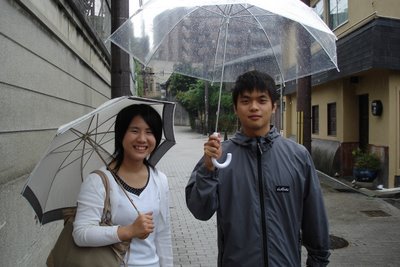
I went to 京都 Kyoto on Sunday with my Nihongo Partners 美和子 Miwako and 昌平 Shohei and it rained the whole time. We gawked at the 外人 foreigners. We began our tour with lunch in a two-floor restaurant where I ordered a bowl of noodles and some tempura that cost me the equivalent of $16. We ended in a very nice cafe where my iced cap put me out around $6. Kyoto is somewhat expensive, even for Japan.
Kyoto is gorgeous though, I'll give it that. It's the city that, back a millenium and a half ago and under a different name, became the capital of the Japanese government and the seat of the 天皇 Emperor. Until the end of the Second World War he, and occassionally she, continued to reside there, but political power was passed into the hands of the 将軍 Shogun around the beginning of the twelfth century, and eventually ended up in 江戸 Edo.
Back in the day it was traditional, for reasons of religious pollution, for the capital to be moved following the death of an Emperor. It was a terribly expensive practice, and was discontinued with the move to Kyoto. The wooden government buildings at the previous capital, 奈良 Nara, were disassembled and dragged by wagons and horses and human sweat to the new and auspicious location, where they were reassembled as best they could be. It's a long trip, but you can do it today in a matter of hours by train.
The plans for Kyoto were based on the Tang dynasty capital of Chang'an, (that's in China) which basically means it was going to be a big square divided into wards with the palace at the top. For geomantic reasons that I would love to get into another time it was aligned with due north, with a river to the east and some hills here and there. I have a map of Chang'an somewhere on my computer, but my computer is in Waterloo and the laptop I brought out here is broken. Boo hiss.
Anyway, that's enough history for now. There are a bunch of really frickin old お寺 Bhuddist Temples and 神社 Shinto Shrines in Kyoto. These are some of them.
As I said, our first stop was a very expensive restaurant. Thence to the heritage of Japan.

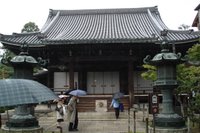
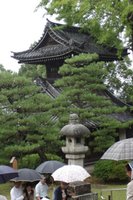
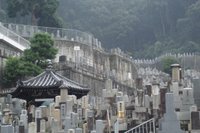
Third was 大谷神社 Ootani Shrine, which venerates I don't know what. Just outside it was a graveyard that spread across the hillside in tiers. It was a terrific sight, awe-inspiring in its shear density and grandeur.
Before that was 八坂神社 Yasaka Shrine, which I didn't get any pictures of, and, though it's currently inhabited by a behemoth of a Shinto mythical figure, Susano-no-O, it was originally a Buddhist temple dedicated to a Hindi god with power over disease whose very long sanskrit name is Jetavanavihara, which was shortened into a Chinese approximation, after which the Japanese approximated the Chinese into 祇園 Gion. Gion, incidentally, is the entertainment district in Kyoto, within which is Yasaka Shrine. Gion (the deity) over time came to be seen as equivalent to Susano-no-O, and was officially supplanted in 1868 by a government decree.
I said no more history, didn't I?
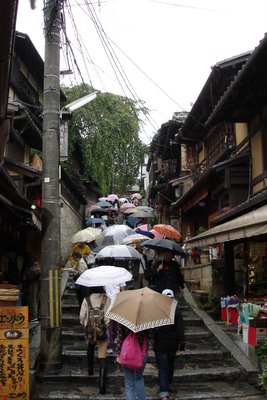
Kyoto was crowded, not just with Japanese but with Foreigners. I think Kyoto is maybe like the CN Tower - a lot more appealing to foreigners. Miwako, for instance, was there for her second time.
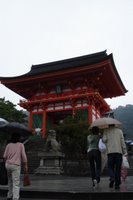
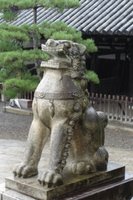
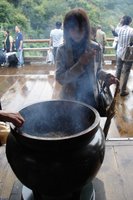
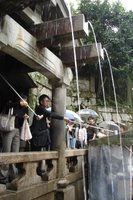
清水寺 Kiyomizu Temple was next. It's huge, and not only huge but gorgeous. Temple, by the way, means Buddhist.
That statue on the right is a 狛犬 Korean Dog, a tradition that apparently was started with Empress Jingu back in the 3rd to 6th century (depending on who you ask) when she is supposed to have conquered Korea. The King of Korea begged for his life like a dog, and the figure has been used to guard the entrances to Japanese temples and shrines ever since.
Under the statue you can see people drinking from an ancient wellspring that has brought good luck to people for, I think, over a millenium. The three different spouts are supposed to be auspicious in three different ways. Shohei says that on the right (your right) you have health and intelligence. Jesse told me later that the middle one is supposed to grant long life. Nobody knew what the one of the left meant.

There are maybe four or six buildings of this size, and some bigger, comprising all of Kiyomizu. It's a good-sized temple.
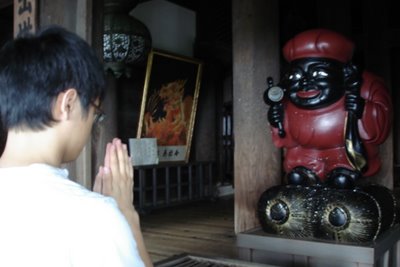
Shoehei prayed in front of this jolly Buddha for wealth and good fortune in business.
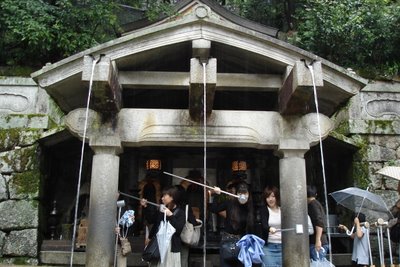
Another shot of the holy wellspring. Needless to say, I drank me some holy water, specifically from the middle spout. I took too much though, and had to empty some of the water onto the ground.
After this we went to a garden, and then another temple where we listened to a chanter work his way through a round of nembutsu - なむ あみだ ぶつ namu amida butsu; Hail Amiddha Buddha, a chant that was introduced to Japan from China by the 天台 Tendai school of Buddhism, which was based right outside Kyoto in the 8th century or so. My camera had, of course, run out of pictures by this point, and I didn't get any shots of the next shrine either.
I'll have to go back, but there are like a gazillion temples in Kyoto, and I don't have that much room on my camera.

1 Comments:
good to hear you updating again.
It's interesting to hear that Kyoto is actually built in the shape of of the capital of Tang dynasty. All Chinese knew about that time period and were very proud of it.
when are you visiting China? and may i ask where are you visiting in China? it is, afterall, the third biggest country in the world.
Post a Comment
<< Home